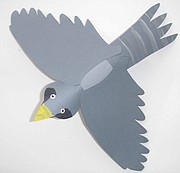CRITTERS OF NORTH IDAHO: Peregrine falcon
Christian Ryan Correspondent | Hagadone News Network | UPDATED 6 years, 11 months AGO
Zooming down from the heavens faster than any other bird is Idaho’s state raptor, the peregrine falcon (Falco peregrinus). Now when I say “raptor,” I’m not talking about a velociraptor. Until relatively recently, the term “raptor” was used only to refer to birds of prey, like eagles, hawks, owls and falcons. Nowadays, thanks to 1993’s Jurassic Park, it is commonly used to describe a sickle-clawed, carnivorous dinosaur, much to the chagrin of ornithologists and paleontologists.
As far as modern raptors go, the peregrine falcon is rather small. It has a wingspan of 3.3-3.6 feet and weighs 18.8-56.5 ounces. One of the ways they make up for their small size is their incredible speed. They tend to cruise at 25-34 mph, and 69 mph when pursuing prey. But when they swoop down upon their prey from the sky, these falcons have been recorded to reach speeds of 200 mph! That makes them not only the fastest flyer, but also the fastest animal on the planet!
Falconry is an ancient practice of using smaller birds of prey to hunt smaller animals, like rabbits and other birds. Archaeological evidence indicates that the practice can be dated back at least 3,500 years to the ancient Mesopotamians and Mongolians. Historically, peregrine falcons have been known as duck hawks because they have been (and still are) the bird of choice for falconers, who often used them to catch ducks.
Before they can catch their prey, the peregrine falcon needs to find it first. Peregrines have a stellar sense of vision thanks to their forward-facing eyes, a feature all birds of prey have. Forward-facing eyes allow the birds to perceive depth perspective, a trait necessary for all pursuit predators.
These birds can spot their prey from at least a mile away; that’s the length of 17 football fields lined up end to end! And if the bird gets something in its eye mid-hunt, it doesn’t even have to stop looking at its target. It simply spreads tears over the surface of its eye with a third, transparent eyelid that clears the debris in a jiffy.
Peregrine falcons are not picky eaters, so their diet commonly consists of carrion, other birds like pigeons and doves, waterfowl, songbirds, seabirds, ravens, crows, smaller hawks, falcons and owls, and mammals such as voles, hares, rabbits, shrews, mice and squirrels. Once their prey is in sight, they unfurl their long talons and swoop down for the kill.
The peregrine falcon isn’t only fast, but it’s also one of the most widespread and adaptable raptors. They can be found on every continent except Antarctica. They thrive in a variety of different wide-open habitats, from coastal and mountain regions to river valleys, deserts and even cities and tundra. Depending on the falcon population in question, peregrine falcons can be migratory (like those living in Idaho) or year-round residents. Some migratory populations of peregrine falcons are known to nest on the Arctic tundra and migrate to overwinter in South America, traveling 15,500 miles a year!
No matter the climate, habitat or region of the world, peregrine falcons seem to thrive, even overcoming seemingly impossible obstacles for wild animals, like living in our towns and cities.
•••
Email Christian at: [email protected]
HOMESCHOOL PROJECT
PAPER TUBE PEREGRINE FALCON
MATERIALS NEEDED:
- Toilet Tissue Roll
- Gray Construction Paper
- Poster Board or Card Stock
- Non-Toxic Tacky Glue
- Pencil or Marker
- Rubber band
- Non-Toxic Paint — Yellow, White, Gray & Black
- Peregrine Falcon Templates
INSTRUCTIONS:
1. Paint a toilet tissue tube gray.
Optional — Make a tube with the gray construction paper the same size as the toilet tissue roll.
2. Use the template to draw or trace separately, the wings, tail and head onto gray paper. Because of the direction the line drawing is facing, when you draw the head you will need to add a beak as shown on the finished project. If you feel craft challenged you can cut out the wings, tail and head. However, you will still need to add a beak to the head.
3. Glue on the tail and head. Use the rubber band to hold them in place while the glue dries.
4. Glue the wings on back and let it dry.
5. Trace feet template onto heavy poster board or cardstock, cut them out, and paint yellow.
6. Cut a slit in bottom of tube that is slightly narrower than top of feet and insert.
7. Reinforce the feet in the tube with the tacky glue.
8. Paint additional features on the falcon such as a beak, eyes, tail stripes.
9. Give the beak a curve by slightly bending it in the center.
If you have been finding these projects helpful please let us know. We would love your feedback.
Project provided by Angel Dominiq
ARTICLES BY CHRISTIAN RYAN CORRESPONDENT

Critters of North Idaho: American Coot
If you see this bird swimming across the water’s surface from a distance, chances are you will mistake it for a duck.

Critters of North Idaho: Northern pike
When we talk about human disturbance of the environment, we usually think of the overharvesting of trees, overhunting and littering. But we can also disrupt the natural balance by introducing species of animals and plants into non-native habitats. This is what happened in the case of the northern pike.

Critters of North Idaho: Ye ol' vole
If you see a little rodent scurrying about in the thicket or under the snow, you may think it’s a mouse. And it may be a mouse, but at first glance it is very difficult to tell a mouse apart from another little rodent, the vole. So difficult, in fact, that voles are often mistakenly referred to as “field mice.” What makes these little scurriers so different from each other? For starters, they belong to different families.





